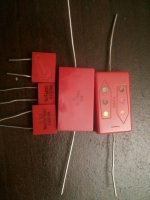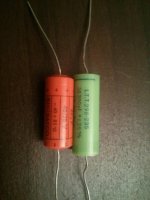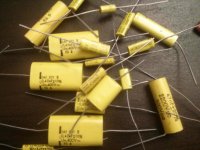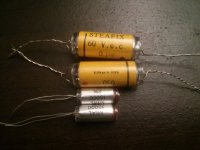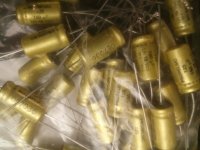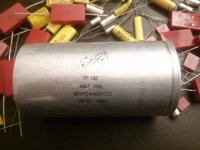Hi,
I am restoring a Thorens AZ-25 tube amplifier with 6973 output tubes.
I have a lot of NOS capacitors on my bench but I don't know a lot about them (are they good for audio, what is the technology used ?).
Have you ever seen or used them ? Thanks in advance 😉
I am using the big one, 68uF in my pass B1 and it sound great, better than the WIMA.
I am restoring a Thorens AZ-25 tube amplifier with 6973 output tubes.
I have a lot of NOS capacitors on my bench but I don't know a lot about them (are they good for audio, what is the technology used ?).
Have you ever seen or used them ? Thanks in advance 😉
I am using the big one, 68uF in my pass B1 and it sound great, better than the WIMA.
Attachments
The electrolytics pictures 4 & 6, I'll use old noes for experimenting but when I button it up I want something that will last more than a few days or 7 years. I had to replace e-caps for low power and low B+ voltage in my ST70 in 1970, 1982, (stored waiting for new tubes) 2010. That was using local distributor caps from the bins out front - nothing special. For long life now I buy aluminum electrolytics rated >3000 service hours from internet only distributors known for sourcing from factory stock, and delivering in bags with part numbers.
Lots of people "reform" e-caps, which you can do with an ohmeter, but the rubber seal , what quality it is can't be determined. Some are 3 year rubber, some are 30 year silicon rubber, depends on what the customer paid for. You could screen for ESR with a $119 meter to sort out trash today, but water could boil out tomorrow, as it did one CDE cap from a salvage house I got 3 hours use from, 1 hour in 1982 and two hours in 2010. Blew the fuse and made a big slime mess in the bottom of the chassis.
The top left caps might be silver mica, test for extreme stability of value over temperature rating with a capacitance meter.
The others, you can't tell what the dielectric is without a manufacturer's catalog from the month they were made. Do test for accuracy with a $30 DVM with cap function before using. To determine dielectric you can test with a DF meter, but if you buy one it would probably be cheaper to buy new capacitors.
I used the cheap film dielectric for paper cap replacement in a dynakit PAS2, and I'm not real satisfied with the results. It is much more trebly and harsh now. I'm not saying you need pricey "audio grade" caps or anything, but polyprophylene seems to be the film of choice among the pros. Then again, polyprophylene is not exactly a clone of 1961 GI paper caps, either. I think cheap plastic caps plus a series inductor may approach the actual value of 1961 paper caps, without the wearout risk. One of my 1961 paper caps was waaay off value, leading to a channel imbalance.
Lots of people "reform" e-caps, which you can do with an ohmeter, but the rubber seal , what quality it is can't be determined. Some are 3 year rubber, some are 30 year silicon rubber, depends on what the customer paid for. You could screen for ESR with a $119 meter to sort out trash today, but water could boil out tomorrow, as it did one CDE cap from a salvage house I got 3 hours use from, 1 hour in 1982 and two hours in 2010. Blew the fuse and made a big slime mess in the bottom of the chassis.
The top left caps might be silver mica, test for extreme stability of value over temperature rating with a capacitance meter.
The others, you can't tell what the dielectric is without a manufacturer's catalog from the month they were made. Do test for accuracy with a $30 DVM with cap function before using. To determine dielectric you can test with a DF meter, but if you buy one it would probably be cheaper to buy new capacitors.
I used the cheap film dielectric for paper cap replacement in a dynakit PAS2, and I'm not real satisfied with the results. It is much more trebly and harsh now. I'm not saying you need pricey "audio grade" caps or anything, but polyprophylene seems to be the film of choice among the pros. Then again, polyprophylene is not exactly a clone of 1961 GI paper caps, either. I think cheap plastic caps plus a series inductor may approach the actual value of 1961 paper caps, without the wearout risk. One of my 1961 paper caps was waaay off value, leading to a channel imbalance.
Last edited:
- Status
- Not open for further replies.
